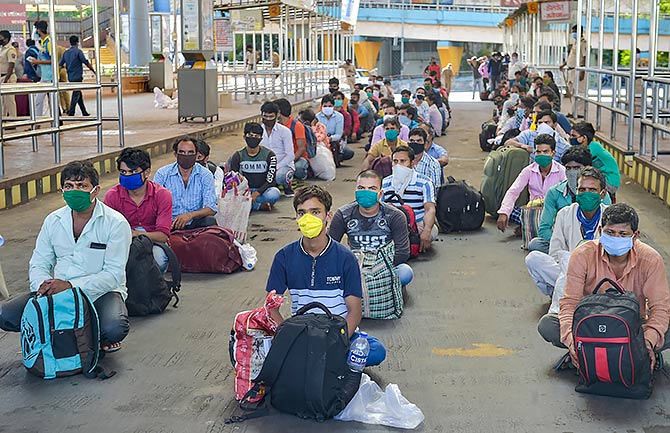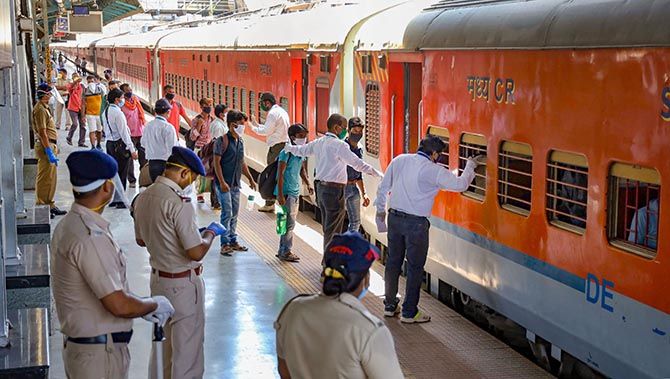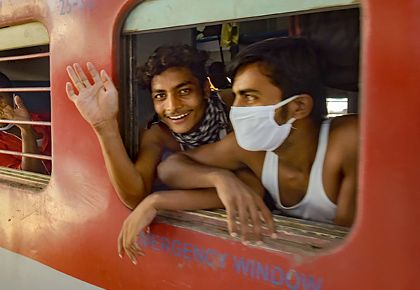 | « Back to article | Print this article |
Official figures say 1.8 lakh workers have returned home to Bihar. Unofficially, that figure is said to have crossed 3 lakhs.
Can Bihar cope?
M I Khan reports.

With thousands of Bihari migrants returning by Shramik trains to Bihar, the state's health and administrative officials worry it may result in a spike in coronavirus cases.
According to officials, 58 special trains have brought back over 70,000 migrant Biharis.
Their apprehension is not baseless.
Dozens among the Biharis who returned to the state in recent weeks tested positive for COVID-19; many more were identified as suspected and sent to isolation wards at various hospitals in the state.
So far, 81 of the returning migrants have tested positive -- including 16 in the last 24 hours.
However, the situation is not yet alarming.
"Till date, only 65 of those who have returned have tested positive. It is a matter of concern, but certainly not a big threat," Bihar Health Secretary Lokesh Kumar Singh told this correspondent on May 7.
The positive cases are spread across 21 of Bihar's 38 districts.
Madhubani, with nine, has the highest number of COVID-19 positive migrants; Rohtas has eight, followed by five each in Patna, West Champaran, Sitamarhi and Aurangabad.
During the ongoing mass screening of every house in the state following Chief Minister Nitish Kumar's directive, Singh said more local people than returning migrants were found to be suffering from cough, fever and cold.
So far more than 8.20 crore people have been tested for the coronavirus in Bihar.
Sanjay Kumar, principal secretary of the state&'s health department, expressed concern that many of the recent positive cases were mostly Biharis who have returned from other states.
"In the last 10 days, nearly 60 to 70 per cent of the samples that tested positive came from those who returned to Bihar," Kumar said.
Another state health department official, who spoke on condition that he would not be identified for this report, added that some of the new cases reported till the end of Lockdown 2.0 were those who had managed to reach Bihar in early- to mid-April.
Most were asymptomatic and had not reported, as required, to their local health centres. This, he said, has resulted on the spread of the disease in districts like Madhubani and Rohtas which had remained untouched during the first phase of the lockdown.
"A large number are returning to Bihar during the third phase of the lockdown. All eyes are on them because several might be infected, resulting in the spread of the virus. But it is difficult to say right now how many of them have tested positive," the official added.
The Bihar health department said 81 per cent of those who had tested for coronavirus did not show symptoms like cold, cough, fever and breathing problems. "This is worrying because those suffering from the disease are unknowingly spreading it to others," said Sanjay Kumar.

Since May 2, daily special trains have been bringing back Biharis stranded across the country. As a result, the Bihar government has increased surveillance and screening.
Senior officials are worried that the flood-prone north Bihar districts, which had remained coronavirus-free till the third week of April, have suddenly reported positive cases. This has happened after the arrival of Biharis from other states, some of whom have tested positive.
The May 8 tally of COVID-19 cases in these districts is: Madhubani, 25; Darbhanga, 5; Sitamarhi, 6; East Champaran, 9; West Champaran, 11.
"It is true that positive cases have been reported in Madhubani after Biharis started returning. Therefore, we have made it mandatory for them to remain in quarantine centres. We are alert and vigilant as we cannot take any risk," Madhubani District Magistrate Dr Nilesh Ramchandra Deore told this correspondent.
Till May 7, Bihar reported 542 coronavirus cases and four deaths from 32 of its 38 districts, with Munger topping at 102.
Of these 542 cases, nearly 400 cases were reported since April 23.
The health department says the spread of coronavirus slowed down in Bihar, with only 11 cases being reported on May 5 and seven cases on May 6.
However, a large number of Biharis are expected to arrive in the coming days.
Information and Public Relation Department Secretary Aunpam Kumar said 24 special trains, bringing at total of 28,427 passengers, reached Bihar on Thursday, May 7. These included eight trains from Gujarat, five each from Maharashtra and Telangana and one train each from Andhra Pradesh, Haryana and Kerala.
This is the highest number of special trains coming to Bihar in a day.
On May 8, 20 trains brought a total of 20,000 migrant workers home.
"The state government has been trying to arrange special trains to Bihar on a daily basis from different states," said Anupam Kumar.
More than 15,000 migrant workers and students returned to Bihar from five states on 13 special trains on May 6.

Pratay Amrit, the disaster management department's principal secretary, noted the influx of Biharis returning from other states is a big challenge for the state administration; they need to be kept in quarantine centres.
Bihar, Amrit said, currently runs 3,100 relief camps that house over 18,000 Biharis who have returned to the state.
A disaster management department official revealed that more than 90 per cent of the calls received on its helpline numbers came from Biharis requesting the state government to make arrangements for their return to Bihar.
The state government has given Rs 1,000 each to more than 19 lakh Biharis who called for help. After validation, the amount has been deposited in their respective bank accounts through the chif minister's special assistance fund.
Purnea District Magistrate Rahul Kumar said the administration is prepared for the large number of returning Biharis. "We have made elaborate arrangements for them," Kumar stated. "They have been put up at quarantine centres with all the basic facilities."
The government has set up quarantine centres in schools, panchayat offices and other available spaces near villages.
According to Rahul Kumar, there is apprehension among the local people, especially villagers, who are not comfortable with the arrival of Biharis from other states.
Purnea is part of the Seemanchal region, home to a large number of Biharis who earn a living outside the state.
According to officials, Seemanchal and Koshi -- which have seven districts between them -- are backward regions with a high rate of poverty. As a result, it is a huge source of cheap migrant labour.

"We are keeping migrant workers at quarantine centres. Students who have come back are on home quarantine. There is no other option to fight the coronavirus," Darbhanga District Magistrate S M Thiyagrajan told this correspondent.
Abhisek Kumar Singh, Gaya's district magistrate, said the administration has been doing its best for returning Biharis. "We expect thousands more to return the next week or two. We have to ensure they follow quarantine guidelines."
Though hundreds of Biharis have returned to the district, Muzaffarpur has not reported any positive case, Muzaffarpur District Magistrate Chandrasekhar Singh said. "It is our responsibility to maintain this in coming days since more will be returning home," Chandrasekhar Singh told this correspondent.
Sanjay Agrawal, secretary, Bihar's road transport department, said the returning Biharis are medically checked on arrival and then sent to their home districts. Over 100 sanitised buses have been arranged by the transport department for this purpose. Keeping social distancing norms in mind, these buses ply at half their seating capacity.
There are reports that the returnees are unhappy with the mandatory 21 day quarantine due to lack of basic amenities and the poor quality of food given to them and have protested at several places.
On May 7, the government issued orders banning the media from visiting quarantine centres.
Don't miss Part 2 of the special report next week!
